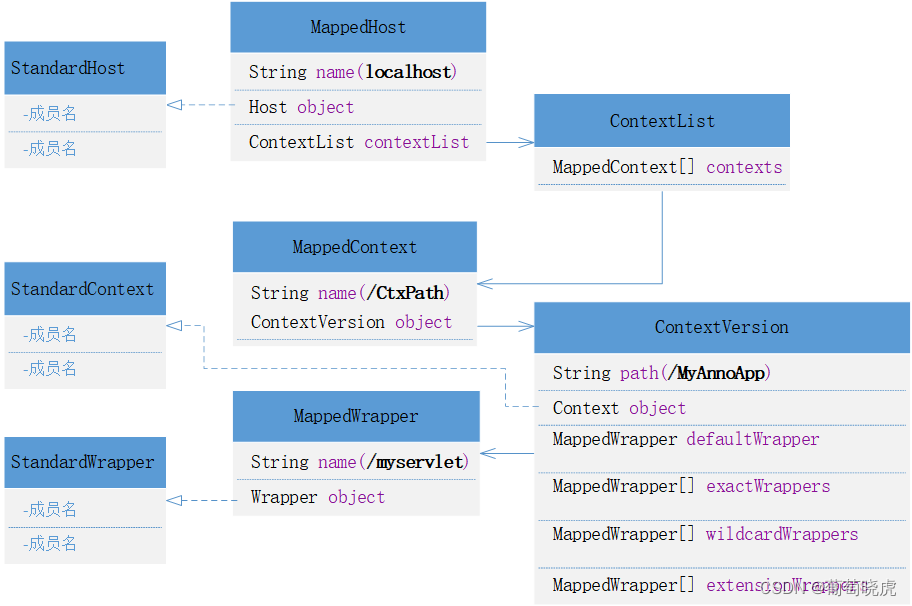tomcat启动时会调用Lifecycle的start()方法,MapperListener.java中的方法startInternal()会被调用,此时开始了请求url映射到容器的初始化之路。首先看下private final Mapper mapper;属性,这个属性包含了请求url到容器的所有映射关系,其中hosts是Host容器的数组。

java
public final class Mapper {
volatile MappedHost[] hosts = new MappedHost[0];
private volatile String defaultHostName = null;
private volatile MappedHost defaultHost = null;
private final Map<Context,ContextVersion> contextObjectToContextVersionMap = new ConcurrentHashMap<>();
}tomcat中请求url与各容器的映射关系保存在Mapper中的,关系图如下:

在tomcat启动阶段会调用MapperListener.java中的模板方法startInternal()
java
public void startInternal() throws LifecycleException {
......
Container[] conHosts = engine.findChildren();
for (Container conHost : conHosts) {
Host host = (Host) conHost;
if (!LifecycleState.NEW.equals(host.getState())) {
// Registering the host will register the context and wrappers
registerHost(host);
}
}
}
private void registerHost(Host host) {
String[] aliases = host.findAliases();
mapper.addHost(host.getName(), aliases, host);
for (Container container : host.findChildren()) {
if (container.getState().isAvailable()) {
registerContext((Context) container);
}
}
// Default host may have changed
findDefaultHost();
if (log.isDebugEnabled()) {
log.debug(sm.getString("mapperListener.registerHost", host.getName(), domain, service));
}
}首先添加host到mapper中,看下这个过程:
java
public synchronized void addHost(String name, String[] aliases, Host host) {
name = renameWildcardHost(name);
MappedHost[] newHosts = new MappedHost[hosts.length + 1];
MappedHost newHost = new MappedHost(name, host);
if (insertMap(hosts, newHosts, newHost)) {
hosts = newHosts;
if (newHost.name.equals(defaultHostName)) {
defaultHost = newHost;
}
if (log.isDebugEnabled()) {
log.debug(sm.getString("mapper.addHost.success", name));
}
} else {
MappedHost duplicate = hosts[find(hosts, name)];
if (duplicate.object == host) {
// The host is already registered in the mapper.
// E.g. it might have been added by addContextVersion()
if (log.isDebugEnabled()) {
log.debug(sm.getString("mapper.addHost.sameHost", name));
}
newHost = duplicate;
} else {
log.error(sm.getString("mapper.duplicateHost", name, duplicate.getRealHostName()));
// Do not add aliases, as removeHost(hostName) won't be able to
// remove them
return;
}
}
......
}使用MappedHost去封装Host,生成的MappedHost会保存在属性hostsvolatile MappedHost[] hosts = new MappedHost[0];中,现在在Mapper中有Host了。Host就是主机嘛,映射域名的。Host是由tomcat解析server.xml文件生成,因此我们可以在server.xml文件中配置Host。接下来是注册Context到Host中registerContext。Context就是加载servlet的文件夹路径,通过这个路径去匹配Context。
java
private void registerContext(Context context) {
......
List<WrapperMappingInfo> wrappers = new ArrayList<>();
for (Container container : context.findChildren()) {
prepareWrapperMappingInfo(context, (Wrapper) container, wrappers);
if (log.isDebugEnabled()) {
log.debug(sm.getString("mapperListener.registerWrapper", container.getName(), contextPath, service));
}
}
mapper.addContextVersion(host.getName(), host, contextPath, context.getWebappVersion(), context, welcomeFiles,
resources, wrappers);
if (log.isDebugEnabled()) {
log.debug(sm.getString("mapperListener.registerContext", contextPath, service));
}
}- 使用WrapperMappingInfo封装Wrapper
使用WrapperMappingInfo去封装mapping映射的请求和Wrapper(StandardWrapper),然后添加到public MappedWrapper[] exactWrappers = new MappedWrapper[0];。
java
private void prepareWrapperMappingInfo(Context context, Wrapper wrapper, List<WrapperMappingInfo> wrappers) {
String wrapperName = wrapper.getName();
boolean resourceOnly = context.isResourceOnlyServlet(wrapperName);
String[] mappings = wrapper.findMappings();
for (String mapping : mappings) {
boolean jspWildCard = (wrapperName.equals("jsp") && mapping.endsWith("/*"));
wrappers.add(new WrapperMappingInfo(mapping, wrapper, jspWildCard, resourceOnly));
}
}- 添加MappedContext
这里有点绕,首先在MappedHost中有个public volatile ContextList contextList;,contextListcontextList中有个contextspublic final MappedContext[] contexts;用来存储MappedContext,这里先用ContextVersion封装Context,再用MappedContext封装ContextVersion,然后保存到MappedHost中。可以看到ContextVersion是包含请求路径的,因此tomcat收到请求时可以根据url定位到对应的ContextVersion。
java
public void addContextVersion(String hostName, Host host, String path, String version, Context context,
String[] welcomeResources, WebResourceRoot resources, Collection<WrapperMappingInfo> wrappers) {
......
int slashCount = slashCount(path);
synchronized (mappedHost) {
ContextVersion newContextVersion =
new ContextVersion(version, path, slashCount, context, resources, welcomeResources);
if (wrappers != null) {
addWrappers(newContextVersion, wrappers);
}
ContextList contextList = mappedHost.contextList;
MappedContext mappedContext = exactFind(contextList.contexts, path);
if (mappedContext == null) {
mappedContext = new MappedContext(path, newContextVersion);
ContextList newContextList = contextList.addContext(mappedContext, slashCount);
if (newContextList != null) {
updateContextList(mappedHost, newContextList);
contextObjectToContextVersionMap.put(context, newContextVersion);
}
} else {
ContextVersion[] contextVersions = mappedContext.versions;
ContextVersion[] newContextVersions = new ContextVersion[contextVersions.length + 1];
if (insertMap(contextVersions, newContextVersions, newContextVersion)) {
mappedContext.versions = newContextVersions;
contextObjectToContextVersionMap.put(context, newContextVersion);
} else {
// Re-registration after Context.reload()
// Replace ContextVersion with the new one
int pos = find(contextVersions, version);
if (pos >= 0 && contextVersions[pos].name.equals(version)) {
contextVersions[pos] = newContextVersion;
contextObjectToContextVersionMap.put(context, newContextVersion);
}
}
}
}
}- 添加Wrapper
这里逻辑也不复杂,还是层层封装。使用MappedWrapper封装WrapperMappingInfo包含的Wrapper和对应的请求路径,再添加到ContextVersion的public MappedWrapper[] exactWrappers = new MappedWrapper[0];即可,注意Wrapper中的请求路径就是servlet的url路径。
java
protected void addWrapper(ContextVersion context, String path, Wrapper wrapper, boolean jspWildCard,
boolean resourceOnly) {
synchronized (context) {
if (path.endsWith("/*")) {
// Wildcard wrapper
String name = path.substring(0, path.length() - 2);
MappedWrapper newWrapper = new MappedWrapper(name, wrapper, jspWildCard, resourceOnly);
MappedWrapper[] oldWrappers = context.wildcardWrappers;
MappedWrapper[] newWrappers = new MappedWrapper[oldWrappers.length + 1];
if (insertMap(oldWrappers, newWrappers, newWrapper)) {
context.wildcardWrappers = newWrappers;
int slashCount = slashCount(newWrapper.name);
if (slashCount > context.nesting) {
context.nesting = slashCount;
}
}
} else if (path.startsWith("*.")) {
// Extension wrapper
String name = path.substring(2);
MappedWrapper newWrapper = new MappedWrapper(name, wrapper, jspWildCard, resourceOnly);
MappedWrapper[] oldWrappers = context.extensionWrappers;
MappedWrapper[] newWrappers = new MappedWrapper[oldWrappers.length + 1];
if (insertMap(oldWrappers, newWrappers, newWrapper)) {
context.extensionWrappers = newWrappers;
}
} else if (path.equals("/")) {
// Default wrapper
MappedWrapper newWrapper = new MappedWrapper("", wrapper, jspWildCard, resourceOnly);
context.defaultWrapper = newWrapper;
} else {
// Exact wrapper
final String name;
if (path.length() == 0) {
// Special case for the Context Root mapping which is
// treated as an exact match
name = "/";
} else {
name = path;
}
MappedWrapper newWrapper = new MappedWrapper(name, wrapper, jspWildCard, resourceOnly);
MappedWrapper[] oldWrappers = context.exactWrappers;
MappedWrapper[] newWrappers = new MappedWrapper[oldWrappers.length + 1];
if (insertMap(oldWrappers, newWrappers, newWrapper)) {
context.exactWrappers = newWrappers;
}
}
}
}至此完成了请求url到servlet相关容器的初始化。